
Extravehicular activity (EVA) is any activity done by an astronaut or cosmonaut outside a spacecraft beyond the Earth's appreciable atmosphere. The term most commonly applies to a spacewalk made outside a craft orbiting Earth, but also has applied to lunar surface exploration performed by six pairs of American astronauts in the Apollo program from 1969 to 1972. On each of the last three of these missions, astronauts also performed deep-space EVAs on the return to Earth, to retrieve film canisters from the outside of the spacecraft. Astronauts also used EVA in 1973 to repair launch damage to Skylab, the United States' first space station.

STS-61-C was the 24th mission of NASA's Space Shuttle program, and the seventh mission of Space Shuttle Columbia. It was the first time that Columbia, the first space-rated Space Shuttle orbiter to be constructed, had flown since STS-9. The mission launched from Florida's Kennedy Space Center on 12 January 1986, and landed six days later on 18 January. STS-61-C's seven-person crew included the second African-American shuttle pilot, future NASA Administrator Charles Bolden, the first Costa Rican-born astronaut, Franklin Chang-Diaz, and the second sitting politician to fly in space, Representative Bill Nelson (D-FL). It was the last shuttle mission before the Space Shuttle Challenger disaster, which occurred just ten days after STS-61-C's landing.

STS-71 was the third mission of the US/Russian Shuttle-Mir Program and the first Space Shuttle docking to Russian space station Mir. It started on 27 June 1995 with the launch of Space Shuttle Atlantis from launch pad 39A at the Kennedy Space Center in Florida. The shuttle delivered a relief crew of two cosmonauts Anatoly Solovyev and Nikolai Budarin to the station and recovered Increment astronaut Norman Thagard. Atlantis returned to Earth on 7 July with a crew of eight. It was the first of seven straight missions to Mir flown by Atlantis.
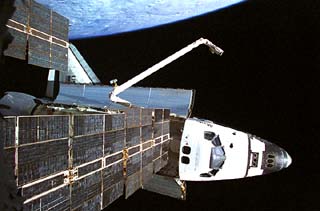
STS-74 was the fourth mission of the US/Russian Shuttle-Mir Program, and the second docking of the Space Shuttle with Mir. Space Shuttle Atlantis lifted off from Kennedy Space Center launch pad 39A on 12 November 1995. The mission ended 8 days later with the landing of Atlantis back at Kennedy. It was the second in a series of seven straight missions to the station flown by Atlantis.
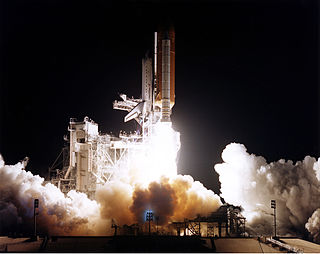
STS-81 was a January 1997 Space Shuttle Atlantis mission to the Mir space station.

STS-86 was a Space Shuttle Atlantis mission to the Mir space station. This was the last Atlantis mission before it was taken out of service temporarily for maintenance and upgrades, including the glass cockpit.
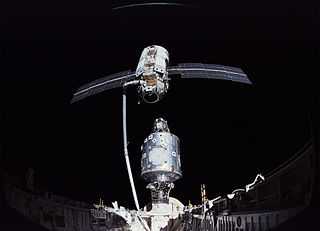
STS-88 was the first Space Shuttle mission to the International Space Station (ISS). It was flown by Space Shuttle Endeavour, and took the first American module, the Unity node, to the station.

STS-97 was a Space Shuttle mission to the International Space Station (ISS) flown by Space Shuttle Endeavour. The crew installed the first set of solar arrays to the ISS, prepared a docking port for arrival of the Destiny Laboratory Module, and delivered supplies for the station's crew.

The Shuttle–Mir Program was a collaborative space program between Russia and the United States, which involved American Space Shuttles visiting the Russian space station Mir, Russian cosmonauts flying on the shuttle, and an American astronaut flying aboard a Soyuz spacecraft to engage in long-duration expeditions aboard Mir.
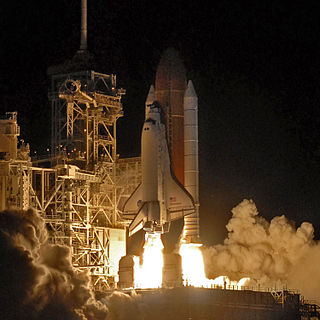
STS-116 was a Space Shuttle mission to the International Space Station (ISS) flown by Space Shuttle Discovery. Discovery lifted off on 9 December 2006 at 20:47:35 EST. A previous launch attempt on 7 December had been canceled due to cloud cover. It was the first night launch of a space shuttle since STS-113 in November 2002.

STS-126 was a Space Shuttle mission to the International Space Station (ISS) flown by Space Shuttle Endeavour. The purpose of the mission, referred to as ULF2 by the ISS program, was to deliver equipment and supplies to the station, to service the Solar Alpha Rotary Joints (SARJ), and repair the problem in the starboard SARJ that had limited its use since STS-120. STS-126 launched on 14 November 2008 at 19:55:39 pm EST from Launch Pad 39A at NASA's Kennedy Space Center with no delays or issues. Endeavour successfully docked with the station on 16 November. After spending 11 days, 16 hours, and 46 minutes docked to the station, during which the crew performed four spacewalks, and transferred cargo, the orbiter undocked on 28 November 2008. Due to poor weather at Kennedy Space Center, Endeavour landed at Edwards Air Force Base on 30 November 2008 at 21:25 UTC.

STS-123 was a Space Shuttle mission to the International Space Station (ISS) which was flown by Space Shuttle Endeavour. STS-123 was the 1J/A ISS assembly mission. The original launch target date was 14 February 2008 but after the delay of STS-122, the shuttle was launched on 11 March 2008. It was the twenty-fifth shuttle mission to visit the ISS, and delivered the first module of the Japanese laboratory, Japanese Experiment Module (Kibō), and the Canadian Special Purpose Dexterous Manipulator, (SPDM) Dextre robotics system to the station. The mission duration was 15 days and 18 hours, and it was the first mission to fully utilize the Station-to-Shuttle Power Transfer System (SSPTS), allowing space station power to augment the shuttle power systems. The mission set a record for a shuttle's longest stay at the ISS.

STS-124 was a Space Shuttle mission, flown by Space Shuttle Discovery to the International Space Station. Discovery launched on 31 May 2008 at 17:02 EDT, moved from an earlier scheduled launch date of 25 May 2008, and landed safely at the Kennedy Space Center's Shuttle Landing Facility, at 11:15 EDT on 14 June 2008. The mission is also referred to as ISS-1J by the ISS program.
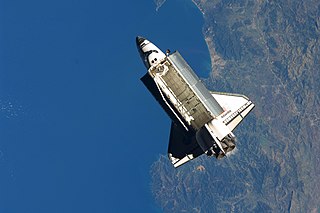
STS-129 was a NASA Space Shuttle mission to the International Space Station (ISS). Atlantis was launched on November 16, 2009 at 14:28 EST, and landed at 09:44 EST on November 27, 2009 on runway 33 at the Kennedy Space Center's Shuttle Landing Facility.

STS-131 was a NASA Space Shuttle mission to the International Space Station (ISS). Space ShuttleDiscovery launched on 5 April 2010 at 6:21 am from Kennedy Space Center's launch pad 39A, and landed at 9:08 am on 20 April 2010 on runway 33 at the Kennedy Space Center's Shuttle Landing Facility. The mission marked the longest flight for space shuttle Discovery.

STS-132 was a NASA Space Shuttle mission, during which Space Shuttle Atlantis docked with the International Space Station on 16 May 2010. STS-132 was launched from the Kennedy Space Center on 14 May 2010. The primary payload was the Russian Rassvet Mini-Research Module, along with an Integrated Cargo Carrier-Vertical Light Deployable (ICC-VLD). Atlantis landed at the Kennedy Space Center on 26 May 2010.

Nicole Marie Passonno Stott is an American engineer and a retired NASA astronaut. She served as a Flight Engineer on ISS Expedition 20 and Expedition 21 and was a Mission Specialist on STS-128 and STS-133. After 27 years of working at NASA, the space agency announced her retirement effective June 1, 2015. She is married to Christopher Stott, a Manx-born American space entrepreneur.

STS-134 was the penultimate mission of NASA's Space Shuttle program and the 25th and last spaceflight of Space ShuttleEndeavour. This flight delivered the Alpha Magnetic Spectrometer and an ExPRESS Logistics Carrier to the International Space Station. Mark Kelly served as the mission commander. STS-134 was expected to be the final space shuttle mission if STS-135 did not receive funding from Congress. However, in February 2011, NASA stated that STS-135 would fly "regardless" of the funding situation. STS-135, flown by Atlantis, took advantage of the processing for STS-335, the Launch On Need mission that would have been necessary if the STS-134 crew became stranded in orbit.

STS-135 was the 135th and final mission of the American Space Shuttle program. It used the orbiter Atlantis and hardware originally processed for the STS-335 contingency mission, which was not flown. STS-135 launched on 8 July 2011, and landed on 21 July 2011, following a one-day mission extension. The four-person crew was the smallest of any shuttle mission since STS-6 in April 1983. The mission's primary cargo was the Multi-Purpose Logistics Module (MPLM) Raffaello and a Lightweight Multi-Purpose Carrier (LMC), which were delivered to the International Space Station (ISS). The flight of Raffaello marked the only time that Atlantis carried an MPLM.
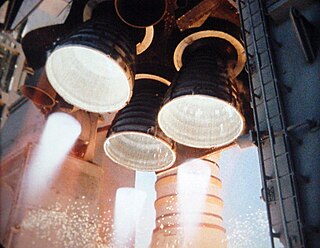
The launch of Space Shuttle missions was governed by a countdown. Two clocks were maintained, the unofficial, but sometimes mentioned, L (launch) clock represented the time remaining before the scheduled launch in real time, and the more often referred to T (test) clock included several built-in holds where additional verifications were made. Built-in holds were extended if mission parameters allowed for additional checks or to correct issues. Launches of the Space Shuttle to the international space station did not allow for holds to be extended due to the launch window which was limited to no more than 10 minutes due to the 90 minute orbit period of the station and speed of Earth's rotation, which puts the launch pads 1,000 miles (1,600 km) east of the station on its next orbit.






















